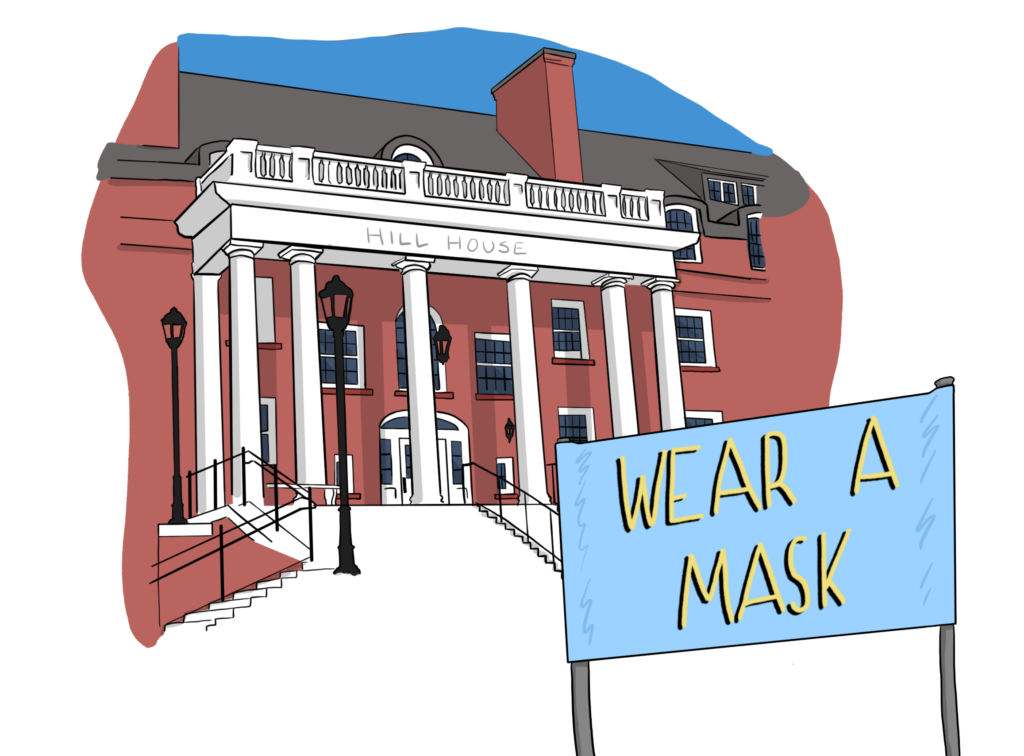
Graphic by Sesame Gaetsaloe/ The Choate News
With last spring’s virtual term essentially used as a trial run for this year’s adaptations to the pandemic, the Choate community has developed numerous ways for the school year to continue smoothly both online and, eventually, in-person.
On September 15, the 131st Convocation took the form of a pre-recorded video featuring a message from Head of School Dr. Alex Curtis and Student Body President Ula Lucas ’21, as well as videos of students sending support and advice to their peers for the upcoming school year.
The many changes to this year include the transformation of the daily academic schedule, which now comprises nine academic blocks that meet three times a week for an hour. The decision to shorten classes from 70 minutes to 60 minutes was made to accommodate more blocks. Classes are in session from 8 a.m. to 9:40 p.m. ET to allow students from different parts of the world to join classes synchronously.
Over the summer, students were asked to express their preferred time zone for classes to ease the burden of having classes at unfavorable times, which posed a challenge in the spring term. The new schedule aims to hold classes at relatively normal waking hours for each student, no matter where they are living.
The spring term proved to be a helpful pilot for virtual learning, and the community offered invaluable feedback to the team tasked with organizing the new schedule. The collaborative effort was led by the Registrar’s Office, with the help of the Dean of Faculty’s Office, including Director of Curricular Initiatives Mr. Deron Chang, Director of Studies Mr. Kevin Rogers, and Director of Faculty Development Mr. Tom White.
Hosting accessible synchronous classes was a foremost priority for the School. Ms. Catherine Velez, the School’s registrar, said, “Having students in class synchronously was our most important goal. We wanted to be able to be sensitive to students across time zones.” She said that her office thought through a variety of scenarios with the understanding that “no one system was ever going to be perfect.”
The synchronous classes aim to provide new students with a means to acclimate to the classroom setting at Choate and make connections with their teachers and peers.
Mr. Rogers said, “One of the things that we benefited from last spring was the fact that we had had two terms together in many of our classes. People were pretty well enculturated into classes, or at least into the Choate academic environment. We knew that this fall, that wouldn’t be the case.”
In addition to synchronous classes, another priority was to facilitate rotation in the academic blocks throughout the schedule to make it as feasible as possible for students to participate at reasonable times. Regardless, students still faced difficulties with their schedule. “I think that there were more students who elected to be remote through the fall term,” Ms. Velez said. “I do think that there are some students who had originally elected to take six classes and that some of them have found that that was too much being remote — in particular if their sixth class was outside of their time band.”
Students had varying responses to the new schedule. Anika Midha ’22 said, “As an international student, I appreciate the administration’s efforts in trying to be more accommodating to different time zones. The schedule has its pros and cons — now I no longer have to stay up through the night, but the amount of continuous sleep I get is limited by my morning classes.” Austin Zhao ’23 said, “I don’t know how I feel about the break in between the day blocks and H block. It’s such a weird, short but long gap. The biggest problem for me might be the disorganization of extra help.”
Office hours and a School Meeting block could not be included in the schedule this year. The hope is for faculty to still find extra help time for students, despite the lack of designated office hours in the schedule.
Mr. Rogers said, “We knew that that 10:30 in the morning [ET] slot was what we affectionately referred to as the ‘golden band’ in the sense that just about everybody in the world is reasonably awake [at that time]. So we knew that that 10:30 slot was going to be especially important for the advisory, college counseling, and form meetings that we wanted to incorporate.”
As for school meetings, Dean of Students Mr. Mike Velez ’00 worked with faculty to ensure students receive the necessary announcements and messages through form meetings and advising, leaving more time in the schedule for academic blocks. If an announcement needs to be delivered to the community as a whole, school meetings will be pre-recorded and sent out as they were last spring.
Although there is an afternoon slot designated for athletics and afternoon activities, adjustments were made to extracurricular activities to accommodate students and facilitate the best learning experience. Some music ensembles such as Symphony Orchestra had their rehearsals moved to take up an academic block in the schedule.
Mr. Rogers acknowledged that the School debated eliminating afternoon activities, including athletics, musical rehearsals, and the like, altogether. But, he said, “the School was especially determined to make that possibility real.”
Dorm life is yet another aspect to the Choate experience that continues to adapt to the virtual environment. Upon boarding students’ arrival to the dorms in October, students will be quarantining in their dorms and taking classes virtually for the quarantine period. Day students, on the other hand, will be quarantining at home and will be assigned a family unit of four other day students.
Mr. Rogers, an adviser in Clinton Knight, said, “I’m hoping that the fun parts of living and working in a dorm — the casual conversations, the common room pieces — I hope that even with the restrictions those pieces. They may not look the same as they have in the past, but we don’t lose that.”
Most safety measures, including the placement of hand sanitizer dispensers and disinfectant sprays in classrooms and the switch from Harkness tables to individual desks in the Humanities building, were ready for the return of students to campus in September. Nevertheless, the delay of the on-campus start to October afforded faculty and staff extra time to familiarize themselves with the necessary safety measures to safeguard the wellbeing of the community.


